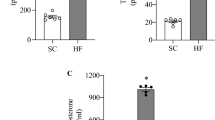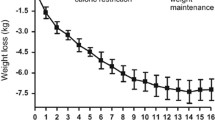Summary
The mechanism by which glucocorticoids induce insulin resistance was studied in normal rats administered for 2 days with corticosterone then tested by euglycaemic hyperinsulinaemic clamps. Corticosterone administration induced a slight hyperglycaemia, hyperinsulinaemia and increased non-esterified fatty acid levels. It impaired insulin-stimulated total glucose utilization (corticosterone 15.7±0.7; controls 24.6±0.8 mg·kg−1·min−1), as well as residual hepatic glucose production (corticosterone 4.9±1.0; controls 2.0±0.7 mg·kg−1·min−1). During the clamps, insulin did not decrease the elevated non-esterified fatty acid levels in corticosterone-administered rats (corticosterone 1.38±0.15, controls 0.22±0.04 mmol/l). Corticosterone administration decreased the in vivo insulin-stimulated glucose utilization index by individual muscles by 62±6%, and the de novo glycogen synthesis by 78±2% (n=8–9 muscles). GLUT4 protein and mRNA levels were either unchanged or slightly increased by corticosterone administration. Inhibition of lipid oxidation by etomoxir prevented corticosterone-induced muscle but not hepatic insulin resistance. In conclusion, glucocorticoid-induced muscle insulin resistance is due to excessive nonesterified fatty acid oxidation, possibly via increased glucose fatty-acid cycle ultimately inhibiting glucose transport, or via decreased glycogen synthesis, or by a direct effect on glucose transporter translocation or activity or both.
Similar content being viewed by others
References
Nosadini R, Del Prato S, Tiengo A et al. (1983) Insulin resistance in Cushing's syndrome. J Clin Endocrinol Metab 57: 529–536
Rizza RA, Mandarino LJ, Gerich JE (1982) Cortisol-induced insulin resistance in man: impaired suppression of glucose production and stimulation of glucose utilization due to a postreceptor defect of insulin action. J Clin Endocrinol Metab 54: 131–138
Venkatesan N, Davidson MB, Hutchinson A (1987) Possible role for the glucose-fatty acid cycle in dexamethasone-induced insulin antagonism in rats. Metabolism 36: 883–891
Block NE, Buse MG (1989) Effects of hypercortisolemia and diabetes on skeletal muscle insulin receptor function in vitro and in vivo. Am J Physiol 256: E39-E48
Riddick FA, Reisler DM, Kipnis DM (1962) The sugar transport system in striated muscle. Effect of growth hormone, hydrocortisone and alloxan diabetes. Diabetes 11: 171–178
Haber RS, Weinstein SP (1992) Role of glucose transporters in glucocorticoid-induced insulin resistance. GLUT 4 isoform in rat skeletal muscle is not decreased by dexamethasone. Diabetes 41: 728–735
Mueckler M (1990) Family of glucose-transporter genes. Implications for glucose homeostasis and diabetes. Diabetes 39: 6–11
James DE, Strube M, Mueckler M (1989) Molecular cloning and characterization of an insulin-regulatable glucose transporter. Nature 338: 83–87
Divertie GD, Jensen MD, Miles JM (1991) Stimulation of lipolysis in humans by physiological hypercortisolemia. Diabetes 40:1228–1232
Randle PJ, Hales CN, Garland PB, Newsholm EA (1963) The glucose fatty-acid cycle: its role in insulin sensitivity and the metabolic disturbances of diabetes mellitus. Lancet I: 785–789
Ferrannini E, Barrett EJ, Bevilacqua S, DeFronzo RA (1983) Effect of fatty acids on glucose production and utilization in man. J Clin Invest 72: 1737–1747
Chambrier C, Picard S, Vidal H, Cohen R, Riou J-P, Beylot M (1990) Interactions of glucagon and free fatty acids with insulin in control of glucose metabolism. Metabolism 39: 976–984
Boden G, Jadali F, White J et al. (1991) Effects of fat on insulin-stimulated carbohydrate metabolism in normal men. J Clin Invest 88: 960–966
Nuutila P, Koivisto VA, Knuuti J et al. (1992) Glucose-free fatty acid cycle operates in human heart and skeletal muscle in vivo. J Clin Invest 89: 1767–1774
Vaag A, Skött P, Damsbo P, Gall M-A, Richter EA, Beck-Nielsen H (1991) Effect of the antilipolytic nicotinic acid analogue Acipimox on whole-body and skeletal muscle glucose metabolism in patients with non-insulin-dependent diabetes mellitus. J Clin Invest 88: 1282–1290
Guillaume-Gentil C, Rohner-Jeanrenaud F, Abramo F, Bestetti GE, Rossi GL, Jeanrenaud B (1990) Abnormal regulation of the hypothalamo-pituitary-adrenal axis in the genetically obese fa/fa rat. Endocrinology 126: 1873–1879
Eistetter K, Wolf HPO (1986) Etomoxir. Drugs Future 12: 1034–1036
Reaven GM, Chang H, Hoffman BB (1988) Additive hypoglycemic effects of drugs that modify free-fatty acid metabolism by different mechanisms in rats with streptozocin-induced diabetes. Diabetes 37: 28–32
Martin C, Odeon M, Cohen R, Beylot M (1991) Mechanisms of the glucose lowering effect of carnitine palmitoyl transferase inhibitor in normal and diabetic rats. Metabolism 40: 420–427
Beato M (1989) Gene regulation by steroid hormones. Cell 56: 335–344
Simmons PS, Miles JM, Gerich JE, Haymond MW (1984) Increased proteolysis. An effect of increases in plasma cortisol within the physiologic range. J Clin Invest 73: 412–420
Terrettaz J, Jeanrenaud B (1983) In vivo hepatic and peripheral insulin resistance in genetically obese (fa/fa) rats. Endocrinology 112: 1346–1351
Ferré P, Leturque A, Burnol AF, Pénicaud L, Girard J (1985) A method to quantify glucose utilization in vivo in skeletal muscle and white adipose tissue of the anaesthetized rat. Biochem J 228: 103–110
James DE, Jenkins AB, Kraegen EW (1985) Heterogeneity of insulin action in individual muscles in vivo: euglycaemic clamp studies in rats. Am J Physiol 248: E567-E574
Chan TM, Exton JH (1976) A rapid method for the determination of glycogen content and radioactivity in small quantities of tissue or isolated hepatocytes. Anal Biochem 71: 96–105
Chomczynski P, Sacchi N (1987) Single-step method of RNA isolation by acid guanidinium thiocyanate-phenol-chloroform extraction. Anal Biochem 162: 156–159
Le Marchand-Brustel Y, Olichon-Berthe C, Gremeaux T, Tanti JF, Rochet N, van Obberghen E (1990) Glucose transporters in insulin sensitive tissues of lean and obese mice. Effects of the thermogenic agent BRL 26830A*. Endocrinology 127: 2687–2695
Klip A, Ramlal T, Young DA, Holloszy JO (1987) Insulin-induced translocation of glucose transporters in rat hindlimb muscles. FEBS Lett 224: 224–230
Haspel HC, Birnbaum MJ, Wilk EW, Rosen OM (1985) Biosynthetic precursors and in vitro translation products of human hepatocarcinoma cells, human fibroblasts and murine preadipocytes. J Biol Chem 260: 7219–7225
Herbert V, Lau KS, Gottlieb CW, Bleicher SJ (1965) Coated charcoal immunoassay of insulin. J Clin Endocrinol 25: 1375–1384
Gwosdow-Cohen A, Chen CL, Besch EL (1982) Radioimmunoassay (RIA) of serum corticosterone in rats. Proc Soc Exptl Biol Med 170: 29–34
Bradford M (1976) A rapid and sensitive method for the quantitation of microgram quantities of protein utilizing the principle of protein-dye binding. Anal Biochem 72: 248–254
Labarca C, Paigen K (1980) A simple, rapid and sensitive DNA assay procedure. Anal Biochem 102: 344–352
Cusin I, Terrettaz J, Rohner-Jeanrenaud F, Jeanrenaud B (1990) Metabolic consequences of hyperinsulinaemia imposed on normal rats on glucose handling by white adipose tissue, muscles and liver. Biochem J 267: 99–103
Garvey WT, Huecksteadt TP, Monzon R, Marshall S (1989) Dexamethasone regulates the glucose transport system in primary cultured adipocytes: different mechanisms of insulin resistance after acute and chronic exposure. Endocrinology 124: 2063–2073
Carter-Su C, Okamoto K (1987) Effect of insulin and glucocorticoids on glucose transporters in rat adipocytes. Am J Physiol 252: E441-E453
Pedersen O, Bak JF, Andersen PH et al. (1990) Evidence against altered expression of GLUT 1 or GLUT 4 in skeletal muscle of patients with obesity or NIDDM. Diabetes 39: 865–870
Wake SA, Sowden JA, Storlien LH et al. (1991) Effects of exercise training and dietary manipulation on insulin-regulatable glucose-transporter mRNA in rat muscle. Diabetes 40: 275–279
Koranyi L, James D, Mueckler M, Permutt MA (1990) Glucose transporter levels in spontaneously obese (db/db) insulin-resistant mice. J Clin Invest 85: 962–967
Kahn BB, Rossetti L, Lodish HF, Charron MJ (1991) Decreased in vivo glucose uptake but normal expression of GLUT 1 and GLUT 4 in skeletal muscle of diabetic rats. J Clin Invest 87: 2197–2206
Zarjevski N, Doyle P, Jeanrenaud B (1992) Muscle insulin resistance may not be a primary etiological factor in the genetically obese fa/fa rat. Endocrinology 130: 1564–1570
Davidson MB, Garvey D (1993) Studies on mechanisms of hepatic insulin resistance in cafeteria-fed rats. Am J Physiol 264: E18-E23
Rennie MJ, Holloszy JO (1977) Inhibition of glucose uptake and glycogenolysis by availability of oleate in well-oxygenated perfused skeletal muscle. Biochem J 168: 161–170
Danforth WH (1965) Glycogen synthetase activity in skeletal muscle. Interconversion of two forms and control of glycogen synthesis. J Biol Chem 240: 588–593
Author information
Authors and Affiliations
Rights and permissions
About this article
Cite this article
Guillaume-Gentil, C., Assimacopoulos-Jeannet, F. & Jeanrenaud, B. Involvement of non-esterified fatty acid oxidation in glucocorticoid-induced peripheral insulin resistance in vivo in rats. Diabetologia 36, 899–906 (1993). https://doi.org/10.1007/BF02374470
Received:
Revised:
Issue Date:
DOI: https://doi.org/10.1007/BF02374470




